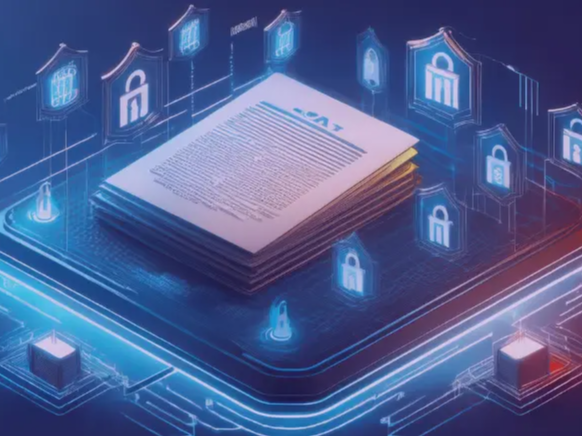Optical Character Recognition (OCR) is a technology that converts text images into machine-readable formats. It allows for the automatic extraction of data and quickly converts text from images into machine-readable formats. It is sometimes referred to as text recognition, as it can extract and reuse data from scanned documents, camera images, and image-based PDFs. The concept of OCR was first proposed by German scientist Tausheck in 1929. In 1974, Ray Kurzweil founded Kurzweil Computer Products, Inc. and launched an OCR product that could recognize nearly any font of printed text. This includes basic OCR, Optical Mark Recognition (OMR), Intelligent Character Recognition (ICR), and Intelligent Word Recognition. By using OCR technology, redundant manual input can be reduced or eliminated, workflows can be simplified, document routing, content processing, and text mining preparations can be automated, storage costs can be reduced, and the most up-to-date and accurate information can be provided to improve services.
What is Optical Character Recognition (OCR)?
Optical Character Recognition (OCR) is a technology that converts text images into machine-readable formats. By automatically extracting data, it can quickly recognize text from scanned documents, camera images, and image-based PDFs. OCR software recognizes the letters in the image as characters, combines them into words, and forms sentences, enabling access to and editing of the original content. It effectively reduces the need for manual data entry, improving work efficiency. The OCR system consists of hardware and software, with hardware such as optical scanners used for reading text, and software responsible for image processing and character recognition. Modern OCR technology is based on Artificial Intelligence (AI) to improve recognition accuracy, including Intelligent Character Recognition (ICR) which can recognize handwritten content and multiple languages.
How does Optical Character Recognition (OCR) work?
Optical Character Recognition (OCR) works by converting printed or handwritten paper documents or images into digital images using devices like scanners and cameras. Preprocessing is a crucial step in OCR technology, including steps such as denoising, binarization, and image correction. Denoising is mainly to eliminate irrelevant information in the image, such as background noise and shadows. Binarization converts color or grayscale images into black-and-white binary images to facilitate subsequent character segmentation. Image correction involves adjusting the angle and shape of the image to make it as close as possible to a standardized state. The image is then segmented to isolate each character. The accuracy of this step directly affects the final recognition result. Common segmentation algorithms include projection-based segmentation and connected component-based segmentation. Features of each character, such as stroke width, tilt angle, and intersection points, are extracted and used as the basis for subsequent recognition. These extracted features are compared with predefined character sets to find the best matching character. This step typically uses classifier algorithms such as Support Vector Machines (SVM) and Neural Networks. The recognition results are then proofread and corrected to improve accuracy. Common post-processing algorithms include rule-based correction and statistical-based correction.
Main applications of Optical Character Recognition (OCR)
OCR technology has a wide range of applications across various fields:
Document digitization: OCR technology can convert paper documents into editable electronic text formats, making them easier to store, retrieve, and share.
Automated data entry: Automatically extracting information from various documents, reducing manual input work and minimizing error rates.
Intelligent recognition: In intelligent traffic systems, OCR technology can be used to recognize license plate numbers for rapid vehicle information retrieval.
ID recognition: In identity verification and financial payments, OCR technology can be used to recognize ID cards, bank cards, and other documents.
Educational scenarios: OCR technology can assist students and teachers in quickly extracting and comparing text information in scenarios like photo-based question search and exam paper grading.
Finance: OCR is widely used in bill processing, ID and passport recognition, credit card bill parsing, anti-fraud, and risk control.
Healthcare: OCR is applied in electronic medical records, health insurance claims, drug label and instruction recognition, as well as health monitoring and analysis.
Transportation: OCR technology is used in license plate recognition, driving license and vehicle registration recognition, ticket management, and courier logistics.
Manufacturing and retail: OCR is used in product quality tracking, warehouse and inventory management, customer invoice management, and barcode and QR code recognition.
Government and public services: Government departments and public organizations use OCR for document digitization, ID management, statistics and data analysis, and public service automation.
Challenges faced by Optical Character Recognition (OCR)
Although OCR technology has made significant progress, there are still several challenges it faces in future development:
Interference from complex backgrounds and lighting conditions: OCR technology often faces interference from various complex backgrounds and lighting conditions in practical applications.
Diversity in fonts and layouts: Different fonts, font sizes, and layout styles can affect OCR's recognition effectiveness.
Character touching and breaking: When characters touch or break apart, it becomes significantly more difficult for OCR to recognize them.
Handwriting recognition: Due to the randomness and individuality of handwriting, OCR technology struggles with recognizing handwritten fonts. The diversity and irregularity of handwriting make it difficult for even advanced OCR systems to achieve the same recognition accuracy as printed text.
Support for multiple languages and special characters: As globalization accelerates, OCR technology needs to enhance support for multiple languages to meet the needs of different countries and regions. Existing technology is still unable to achieve ideal recognition results for non-Latin characters such as Chinese, Japanese, and Arabic.
Privacy protection and data security: As OCR technology becomes more widely used, privacy protection concerns are becoming more prominent. Ensuring user data security and credibility during the use of OCR technology is a problem that needs urgent attention.
Real-time recognition and dynamic processing: As computing power improves and algorithms are optimized, OCR technology will place more focus on real-time recognition for fast processing and analysis of image information.
Integration and innovation with other technologies: OCR technology will deeply integrate with technologies like Natural Language Processing (NLP), Computer Vision, and Big Data to form more comprehensive and efficient solutions.
Expanding application scenarios: OCR technology will be applied in more fields, including but not limited to finance, logistics, healthcare, and education.
The demand for high-precision recognition: With advancements in deep learning and artificial intelligence, OCR technology's accuracy and adaptability have significantly improved. In the future, OCR technology is expected to make breakthroughs in the following areas: integration with deep learning, multi-modal information fusion, personalized customization, mobile terminal applications, and cross-language OCR.
Development prospects of Optical Character Recognition (OCR)
The future development of OCR technology is full of both challenges and opportunities. As technology continues to progress and application scenarios expand, OCR will play a greater role in improving people's work and life efficiency. Future research will focus on improving OCR's adaptability, accuracy, and real-time performance in complex scenarios, while also emphasizing user privacy and data security. Through interdisciplinary collaboration and innovation, OCR technology is expected to achieve broader application and deeper integration in the future.








